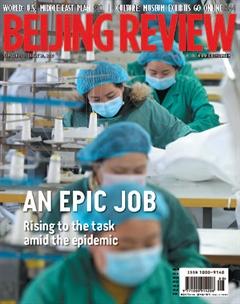Decisive Battle Against Poverty
By Ji Jing


Although schedules have been disrupted and programs postponed by the novel coronavirus outbreak, the release of the Central Governments fi rst policy statement of the year—the No.1 Central Document—on February 5 showed that China remains resolute in eradicating absolute poverty by the end of 2020. Agriculture, rural areas and farmers issues remained the focus of the document for the 17th consecutive year.
Experts said with all the stops pulled out to fight the outbreak of the novel coronavirus pneumonia, the release of the document on schedule is of special signifi -cance.
“I think this is a very important signal. It shows that even as we are hit by the novel coronavirus, we still need to win the battle against poverty,” said Zhang Hongyu, Deputy Director of the China Institute for Rural Studies of Tsinghua University.
This battle is crucial for building a moderately prosperous society in all respects, and is nearing completion. The document also laid out tasks to improve the weak links in infrastructure and public services in rural areas and ensure the supply of important agricultural products. Increasing farmers income and improving rural governance were also highlighted.
Major tasks
In 2020, China is looking to achieve two important goals: complete the building of a moderately prosperous society in all respects and eradicate absolute poverty. To accomplish these targets, the last barriers in the battle against poverty need to be overcome and the weak areas in agriculture, farmers issues and rural areas need to be improved, the document noted.
According to National Bureau of Statistics fi gures released in January, by the end of 2019, over 5.5 million impoverished people lived in rural areas, 11.09 million fewer than the previous year. Given this rate of poverty reduction, it is not diffi cult to realize the target of rooting out poverty this year. However, the remaining impoverished areas and population are all tough nuts to crack.
At a press conference on February 5, Han Changfu, Minister of Agriculture and Rural Affairs, called for efforts to ensure deeply impoverished areas, which have harsh natural conditions and inadequate public services, get out of poverty on schedule. Special impoverished groups should get rid of poverty with the help of social security policies, he said.
Han pinpointed inadequate infrastructure and backward public services as the most prominent problems in peoples livelihood in rural areas and the most glaring proof of unbalanced urban-rural development.
In view of this, the document focused on improving eight weak links in rural areas. Public infrastructure, water supply, the living environment and education have to be improved, along with medical care, social insurance and public cultural services. Environmental protection also needs to be enhanced.
Zheng Fengtian, a professor with the School of Agricultural Economics and Rural Development at Renmin University of China, said that in the past, the work of narrowing the gap between urban and rural areas focused on improving rural residentsincome. However, increasing income alone cannot attract farmers back to their hometowns. Improving the eight weak areas will mean better infrastructure and public services, which will narrow the urban-rural divide. The improved facilities will persuade
many migrant workers to return home. This will be the focus of rural work for a long time to come.
In Quchangcheng, a village in Hebei Province in north China, drinking water used to be a severe problem. The water in the old wells was not up to the standard while new water sources couldnt be found. The local government fi nally hired a professional hydrogeological team to drill two wells in 2019, thus addressing the problem.
Such improvements cannot be achieved without policy support and various guarantees. The document rolled out new measures for ensuring talent, land and funding for improving weak areas.
To ensure adequate talent, it encouraged researchers, engineers, architects, teachers and doctors to work in rural areas. For land supply, it said the system of land use for rural industry development will be improved. Collectively owned rural land will be allowed to be used for developing rural industries through renting or shareholding.
In terms of funding, both the central and local governments will increase their spending on rural areas, farmers and agriculture. New forms of agricultural entities such as family farms will get preferential credit and enjoy the favorable tax policies available to micro and small enterprises.
Other issues
Doubling urban and rural residents income in 2020 compared to 2010 was a quantitative criterion of a moderately prosperous society set at the 18th National Congress of the Communist Party of China in 2012. To achieve this goal, the document highlighted the importance of developing rural industries to increase farmers income. It said the government will support different areas to establish complete industrial chains based on their resources, establish a system for farmers to share the dividends of the industrial chains and form competitive industrial clusters.
Zhang said different localities should focus on their unique agricultural resources to develop distinctive rural industries. For instance, northeast Chinas advantages lie in grain production while south China is known for fruit and tea planting.
Grain security, which has always been a key task of rural work, was also mentioned in the document. It emphasized stabilizing grain production through measures such as improving the subsidy system for farmers, which includes subsidies for buying machinery and seeds. The total graingrowing area and output should stay stable in 2020.
Han said the grain output has stayed above 650 billion kg for five consecutive years, which means grain supply is overall ample. However, the foundation for grain production capacity is not solid. Once a supply shortage occurs, it will affect social stability. Therefore, the more complicated the economic situation is, the more important it is to stabilize agriculture and grain production.
Reduction of hog production and the rise of pork prices was an important livelihood issue in 2019. The document highlighted accelerating hog production recovery in 2020, and made it clear that stabilizing hog production and ensuring pork supply is an important task. The target is to have production approach previous years level by the end of 2020.
Hog production is also a means for escaping poverty. In Zitong, a county in Sichuan Province, southwest China, hog farmer Jia Weilun is raising his animals with the support of a large cattle breeding enterprise. The company provides the piglets and their feed, guides Jia on preventing swine epidemics, and buys the pigs when they mature. Through this model, medium and small pig farmers like Jia have overcome fund shortages and weak epidemic prevention capabilities. Before the Spring Festival, Jia earned nearly 900,000 yuan($128,900) by selling over 2,000 pigs he had raised in about six months.


Last but not the least, the document stressed the importance of consolidat- ing the results of poverty alleviation so that those out of poverty do not slide back. It called for establishing a longterm mechanism for poverty reduction through measures such as improving the system for detecting and monitoring the impoverished.

